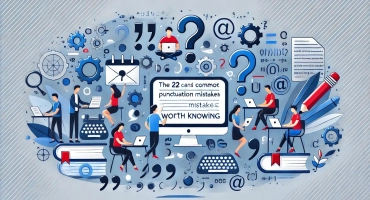Punctuation Marks in Writing: Essential Guide for Flawless Essay
Table of contents
- 1 What Is Punctuation?
- 2 Common Punctuation Marks
- 3 Comma
- 4 Comma Splice
- 5 Period
- 6 Apostrophe
- 7 Quotation Mark
- 8 Question and Exclamation
- 9 Hyphen and Dash (En dash, Em dash)
- 10 Parenthesis, Bracket, Braces
- 11 Ellipsis
- 12 Colon
- 13 Semicolon
- 14 Capitalization
- 15 Make Your Essay Stunning with Accurate Punctuation Marks
Are you struggling to master punctuation in your essays, assignments, or written work? Look no further! In this article, we will explore the importance of punctuation and how PapersOwl can assist you in acing this vital aspect of writing.
Punctuation is crucial in conveying your texts’ meaning, clarity, and coherence. Whether you struggle with commas, semicolons, or dashes, PapersOwl is here to help. With their expert writing assistance and comprehensive proofreading services, you can enhance your punctuation skills and elevate the quality of your academic or professional work.
Let’s dive in and discover the different punctuation marks and why PapersOwl can be your ultimate punctuation companion.
Key points to be covered:
- How to use punctuation correctly
- The significance of punctuation in effective writing
- Common punctuation mistakes to avoid
- Enhancing clarity and coherence through proper punctuation
- Tips for mastering punctuation in essays, assignments, and more
What Is Punctuation?
Punctuation refers to the marks and symbols used in formal writing to enhance clarity, convey meaning, and guide the reader’s understanding. It includes commonly recognized punctuation marks such as commas, periods, question marks, and exclamation points.
Proper punctuation is crucial in English language academic writing essays, as it helps structure ideas, organize information, and maintain coherence. PaperOwl follows all essential rules in academic essays to give your work a professional and clean look. Rest assured, with us, scoring high grades is inevitable.
Common Punctuation Marks
Common punctuation marks play a fundamental role in written communication. They include the comma, period, question mark, exclamation point, and colon. Here are the most common punctuation marks you need to know about:
Comma
A comma serves various purposes in a sentence. It clarifies and organizes the sentence by indicating natural pauses and separating different sentence parts.
Incorrect: I went to the store and bought some groceries.
Correct: I went to the store, and I bought some groceries.
A comma is missing between the two independent clauses in the incorrect example. Adding a comma, as shown in the correct example, separates two sentences appropriately and improves clarity.
Point to Remember:
Use commas purposefully, avoiding overuse or omission. Proper comma usage enhances readability and ensures clarity in your writing. If you need guidance on how to start an autobiography essay, PapersOwl can help refine your approach.
Other Places to Use Commas:
To separate items in a series:
- Her favorite colors are red, blue, and green.
When you look for topics for an opinion essay, choose something you can explain clearly and argue about.
To set off introductory elements:
- After finishing her work, she went for a walk.
To indicate a pause between two sentences in a compound sentence:
- He studied hard, but he didn’t pass the exam.
To separate coordinate adjectives:
- She wore a beautiful, elegant dress to the party.
To set off nonessential information:
- John, my best friend, is coming over for dinner.
To indicate direct address:
- Mom, I need your help with this math problem.
Comma Splice
A comma splice occurs when two complete sentences are joined together using only a comma, without a coordinating conjunction or correct punctuation. Much like in writing this i believe statements, clarity and proper punctuation are essential for effective communication.
Incorrect: I enjoy hiking, it helps me relax.
Correct: I enjoy hiking. It helps me relax.
In the incorrect example, the two independent clauses “I enjoy hiking” and “it helps me relax” are incorrectly joined with only a comma. The correct example shows the appropriate separation of the two sentences into separate sentences or the use of coordinating conjunctions like “and” or “but” to connect them.
Point to Remember: Avoid using a comma alone to join two independent sentences. Instead, use a coordinating conjunction (such as “and,” “but,” “or”) or separate the clauses into individual sentences.
Comma splices can be found in various writing situations, such as:
- Combining two complete sentences with a comma:
Incorrect: She loves swimming, it’s her favorite activity.
Correct: She loves swimming. It’s her favorite activity.
- Using a comma to separate ideas in a series of complex phrases:
Incorrect: He was tired, he had worked late, he needed rest.
Correct: He was tired because he had worked late, and he needed rest.
- Joining independent clauses in compound sentences without proper punctuation:
Incorrect: We went to the beach, the weather was perfect.
Correct: We went to the beach, and the weather was perfect.
In each incorrect example, a comma joins independent clauses without proper punctuation. The correct examples demonstrate the use of appropriate punctuation, such as replacing the comma with a period or using a coordinating conjunction (like “because” or “and”) to connect the clauses.
Period
A period is a correct punctuation mark that indicates the end of a declarative sentence or an imperative sentence that is not a command. It is a small dot placed at the end of a sentence.
Incorrect: She is going to the store. To buy some groceries.
Correct: She is going to the store to buy some groceries.
In the incorrect example, an unnecessary space exists before the period, creating an error. The correct example demonstrates the proper placement of the period without any additional spaces.
Point to Remember: Always place a period at the end of a complete sentence to signify its conclusion.
Other places a period is used:
- Abbreviations: e.g., Mr., Dr.
- Decimal numbers: 3.14, 25.50
- Acronyms: NASA, FBI
- Website addresses: www.example.com
Apostrophe
Apostrophes, which look like single quotation marks, have multiple uses in English writing. It primarily indicates possession or apostrophe replaces letters in contractions.
Incorrect: The dog’s are barking loudly.
Correct: The dogs are barking loudly.
In the incorrect example, the apostrophe is incorrectly placed before the “s” in “dogs,” suggesting possession instead of indicating the plural form. The correct example demonstrates the absence of the apostrophe when showing the plural noun.
Point to Remember: Use an apostrophe to show possession by adding ‘s to the noun, except for plural nouns ending in “s,” where only an apostrophe is added. For contractions, use an apostrophe to replace omitted letters.
Other places where the apostrophe is used:
- Possessiveness: John’s book, the cat’s toy
- Contractions: can’t (cannot), don’t (do not), it’s (it is)
- Numbers and omissions: ’80s (1980s), rock ‘n’ roll (rock and roll)
- When apostrophe is not used: pronouns (hers, its), plurals (dogs, cats), decades (the 1990s)
Quotation Mark
The question mark is used at the end of a sentence to indicate a direct question.
Incorrect: She said, “I love cooking”.
Correct: She said, “I love cooking.”
The closing quotation mark is missing in the incorrect example, resulting in incorrect punctuation. The correct example includes the opening and closing quotation marks, properly enclosing the direct speech.
Point to Remember: Use double quotation marks (” “) to enclose direct speech, dialogue, or a quotation within a sentence.
Other places quotation marks are used:
- Long direct quotations: When using quotation marks, a substantial amount of text (typically four or more lines) uses block indentation or formatting instead of quotation marks.
- Direct quotations: Use quotation marks to enclose the exact words spoken by someone.
- Indirect quotations: When paraphrasing or summarizing someone’s words or ideas, quotation marks are unnecessary.
For example:
- Long direct quotation: According to the author, “The story begins…”
- Direct quotation: She exclaimed, “I can’t believe it!”
- Indirect quotation: He mentioned that he was excited about the upcoming event.
Question and Exclamation
Question Mark
The question mark is a punctuation mark used at the end of a sentence to indicate a direct question.
Incorrect: She is coming to the party right?
Correct: Is she coming to the party?
In the incorrect example, the question mark is incorrectly placed at the end of a statement instead of forming a direct question. The correct example uses the question mark to properly indicate an interrogative sentence, asking whether the person mentioned is coming to the party.
Point to Remember: Use a question mark at the end of a sentence to indicate a direct question.
Question marks are also used in various cases, such as rhetorical questions, indirect questions, and to express uncertainty or doubt. They can also be used in certain expressions or phrases that convey a questioning tone or seek clarification. For example, “Who doesn’t love a good cup of coffee in the morning?”
Exclamation Point
Exclamatory sentences or exclamation marks express strong emotions, surprise, emphasis, or exclamatory statements.
Incorrect: The cake is delicious!
Correct: Wow! The cake is absolutely delicious!
In the incorrect example, the exclamation mark is used to state a fact without conveying a strong emotion. The correct example adds an enthusiastic “Wow!” to show genuine excitement and emphasize just how delicious the cake truly is.
Point to Remember: Use an exclamation mark to express strong emotions, excitement, emphasis, or exclamatory statements.
Hyphen and Dash (En dash, Em dash)
Hyphen
A hyphen (-) is used to combine words or parts of words and create compound adjectives and words.
Incorrect: The well-known scientist.
Correct: The well-known scientist.
En Dash
An en dash (–) indicates a range or connection between two things, such as numbers, dates, or places.
Incorrect: The event is scheduled for 5-7pm.
Correct: The event is scheduled for 5–7 pm.
Em Dash
An em dash (—) is a versatile punctuation mark that indicates a significant break in thought or a parenthetical statement. It is usually written without spaces on either side, although some style guides do recommend using spaces.
When in doubt, opt for no spaces, and make sure you’re consistent throughout your text, whatever you choose. The em dash can add emphasis or drama to a sentence—drawing attention to an important point—or it can create a strong interruption in thought.
Incorrect: She packed her bags – which were brand new – and left.
Correct: She packed her bags—which were brand new—and left.
Other places where Hyphens and Dash are used:
- Hyphen: Used in compound words (e.g., well-known), prefixes (e.g., pre-existing), and suffixes (e.g., self-confidence).
- En Dash: Used to indicate a range (e.g., pages 10–15), connections between places (e.g., New York–London), or connections between dates (e.g., 2010–2015).
- Em Dash: Used to set off parenthetical statements (e.g., She—along with her friends—decided to go), indicate a sudden change in thought, or create emphasis in a sentence.
Parenthesis, Bracket, Braces
Parenthesis ( )
Parentheses are punctuation marks that enclose additional or explanatory information within a sentence.
Incorrect: The weather is nice (I hope so).
Correct: The weather is nice (I hope so).
Bracket [ ]
Brackets are punctuation marks that enclose inserted information or editorial comments within a quoted text.
Incorrect: She said, “I am [not] going to the party.”
Correct: She said, “I am not going to the party.”
Braces { }
Braces are punctuation marks used in mathematics, programming, or to show sets or groups.
Incorrect: The equation {x + 2 = 5} is solved.
Correct: The equation x + 2 = 5 is solved.
Point to Remember:
- Parenthesis: Use parentheses to enclose additional or explanatory information that is not essential to the main sentence but provides extra context or clarification.
- Bracket: Use brackets to enclose inserted information within a quotation, especially when the inserted content is not part of the original quotation.
- Braces: Use braces in mathematics, programming, or to indicate sets or groups.
Other places where Parenthesis, Brackets, and Braces are used:
- Parenthesis: Used in writing to clarify or provide additional information (e.g., “The concert (which was sold out) was amazing.”).
- Bracket: Used in quotations to add editorial comments or clarifications (e.g., “He said, ‘I am [not] going to the party.'”).
- Braces: Used in mathematics or programming to indicate sets or groupings (e.g., “{1, 2, 3}” represents a set of numbers).
Ellipsis
An ellipsis (…), or three periods, consists of three dots that indicate the omission of words, a pause, or trailing off in thought.
Incorrect: I went to the store and bought… milk, bread, and eggs.
Correct: I went to the store and bought… milk, bread, and eggs.
The ellipsis is incorrectly placed after “bought,” disrupting the sentence flow in the incorrect example. The correct example shows the proper use of an ellipsis to indicate an omission.
Point to Remember: Use an ellipsis to indicate the omission of words in a quotation, pause, or trailing off in thought. An ellipsis usually consists of three dots with spaces between each dot.
Other places Ellipses are used:
- In literature: “She whispered, ‘I love you… forever.'”
- In quotations: “To be, or not to be…”
Colon
A colon (:) is a punctuation mark consisting of two dots, one above the other. It is primarily used to introduce or emphasize information in a sentence.
Incorrect: She went to the store: milk, bread, and eggs.
Correct: She went to the store and bought the essentials: milk, bread, and eggs.
In the incorrect example, the colon is misused to separate the subject from the bought items. The correct example demonstrates the proper use of a colon to introduce a list.
Point to Remember: Use a colon after an independent clause to introduce or emphasize information that follows it. The colon indicates that what comes after it is closely related to and expands upon what precedes it.
Other places Colon is used:
- In time expressions: The train departs at 9:00 AM: don’t be late.
- In titles and subtitles: Chapter 3: The Final Showdown.
- In ratios or proportions: The recipe calls for a 2:1 flour-to-water ratio.
- In formal greetings or salutations: To Whom It May Concern:
- In biblical references: John 3:16 is a well-known verse.
Semicolon
A semicolon (;) is a punctuation mark that functions as a stronger pause than a comma but not as final as a period. It joins closely related independent clauses or separates items in a series when the items contain internal punctuation.
Incorrect: She loves reading books; her favorite genre is fantasy.
Correct: She loves reading books; however, her favorite genre is fantasy.
In the incorrect example, the semicolon in the phrase could confuse students who might need assistance with their writing. To avoid such mistakes, many students choose to write my paper online, a service that ensures their papers are grammatically correct and well-structured. The correct example demonstrates the proper use of a semicolon to join two closely related independent clauses.
Point to Remember: Use a semicolon to connect two closely related independent clauses without a coordinating conjunction or to separate items in a series when the items contain internal punctuation.
Other places Semicolon is used:
To separate items in a series when the items contain commas:
The restaurant offers various options: pasta with tomato sauce, a classic Italian dish; pizza with mushrooms, onions, and olives; and salad with feta cheese, walnuts, and balsamic vinaigrette.
Capitalization
Capitalization is using capital letters (uppercase) at the beginning of a word to signify its importance or to distinguish it from other words in a sentence.
Incorrect: i went to the store to buy groceries.
Correct: I went to the store to buy groceries.
In the incorrect example, the sentence starts with a lowercase “i” instead of the capitalized “I.” The correct example demonstrates the proper capitalization of the pronoun “I.”
Point to Remember: Capitalize the first letter of a sentence, proper nouns (names of people, places, organizations), and the pronoun “I.” Lowercase letters are used for common nouns unless they are part of a title or heading.
Stuck on how to structure your essay? Our article on philosophy outlines will show you the way to clarity and coherence.
Other places Capitalization is used:
- Titles: Capitalize the main words in titles of books, articles, movies, etc. (e.g., “Harry Potter and the Chamber of Secrets”).
- Proper adjectives: Capitalize adjectives derived from proper nouns (e.g., American cuisine, Shakespearean sonnets).
- Acronyms: Capitalize all letters in acronyms (e.g., NASA, UNESCO).
- Days, months, and holidays: Capitalize the names of days (e.g., Monday), months (e.g., January), and holidays (e.g., Christmas).
Make Your Essay Stunning with Accurate Punctuation Marks
Now you know how to use proper punctuation. Proper grammar and punctuation play a crucial role in enhancing the quality and impact of your essay. Accurate punctuation ensures clarity, coherence, and readability. To make your essay truly shine, consider utilizing professional editing services.
If you want to edit any paper from a professional service provider, PaperOwl is the perfect option. We will meticulously review and polish your essays. Visit PapersOwl’s website to elevate the punctuation quality of your essay and take it to the next level.
In addition to punctuation, you can also learn how rhetorical topics can improve your writing.







